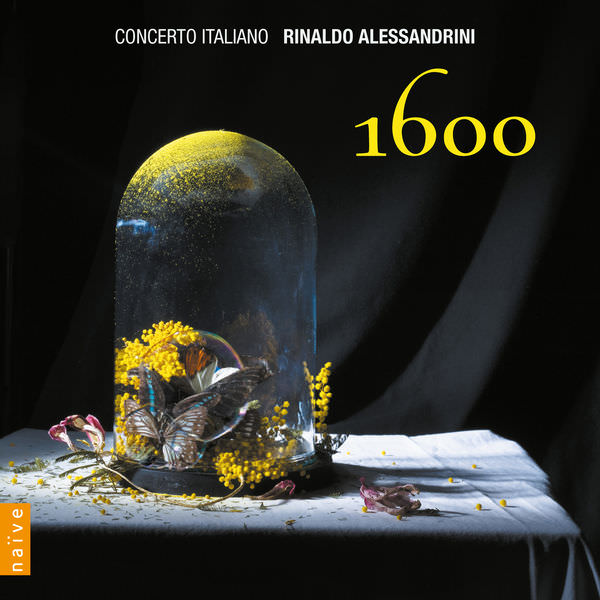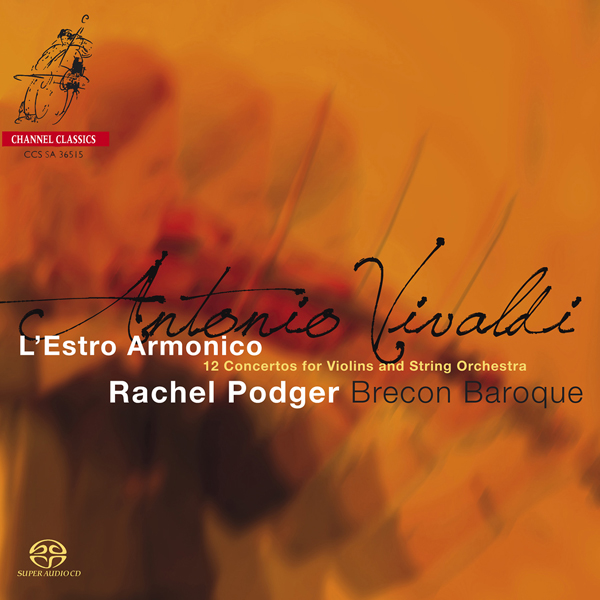
Concerto Italiano, Rinaldo Alessandrini – 1600 (2011/2012)
FLAC (tracks) 24 bit/96 kHz | Time – 01:06:43 minutes | 545 MB | Genre: Classical
Studio Masters, Official Digital Download – Source: Qobuz | Front Cover | © naïve classique
More than any question of instruments, strings, bows, tunings, or temperaments, the modern historical performance movement is about attitude—the desire to find in ancient music a living voice, filtered through vigorous scholarship, willing to experiment and push boundaries, and, most of all, capture the depths of emotion hidden in the score. Rinaldo Alessadrini and Concerto Italiano are some of the most successful exponents of this idiom, having recorded the complete Monteverdi madrigals on Opus 111 (highly recommended) as well as a host of other albums, from the birth of the Baroque to Bach and Vivaldi. In this album, simply titled 1600, Alessandrini has created a program that traces the rise of Italian four-part instrumental music from its earliest parting with vocal models to the rise of the string concerto, foreshadowing the development of the string quartet. In less capable hands, such an undertaking could have produced another mixed bag of early Baroque hits and misses. However, Alessandrini’s well chosen and elegantly assembled program never falters, guiding the listener with a gentle hand through the evolution of music from elaborations on Renaissance polyphonic models to the birth of the galant.
Only two works on the disc were not originally written for strings, transcribed by Alessandrini, as was fairly common practice of the time, for the ensemble at hand—in this case, two violins, viola, cello, and a continuo group of theorbo and keyboard. Giovanni de Macque’s brief and appealing Consonanze stravaganti is aptly named, a rich and pleasing treat for the senses, rendered even more so by the ensemble’s lush string tone—anyone who would argue that period instruments lack the warmth and richness of modern strings needs to listen to this. Tarquinio Merula’s Capriccio Cromatico hearkens back to the mannerist extravagance of Gesualdo’s vocal works, yet is tamed by the new monodic style made famous by Monteverdi. Merula’s canzona La Chremasca highlights the viola playing of Ettore Belli, a sweet and resonant color that adds a welcome touch of tenor richness to the ensemble.
The Passacaglia by Biagio Marini, one of Italy’s first virtuosi, showcases the ensemble’s admirable control of affect and instrument. They are not afraid to take their time, indulging in the art of the adagio , tantalizing the ear at cadences with energetic embellishments. Scorching dissonances melt into their resolutions, made even more powerful by a colorful historical temperament and fine attention to intonation. Moreover, they never lose sight of the irrepressible dance that permeates so much of this repertoire, and which makes this album such a delight. Rhythms are crisp and clear; articulations are precise and never devolve into mere busyness. The brief dance movements from Zanetti’s Il Scolaro are fun and jovial, and stand in stark contrast to the more introspective and mournful selections, especially the anonymous fantasy “The Tears of Orpheus Having Lost His Wife” that opens the album. Violinists Mauro Lopes Ferreira and Nicholas Robinson prove their mettle with the precision bellicosity of Dario Castello’s Sonata Decimasesta from his second collection of sonatas (1644). My only wish is that they took more risks with improvisation; there is a wild dimension to this music that needs to be allowed to run free, the only thing holding this excellent album back from being extraordinary.
The final four works on the album cleverly and succinctly illustrate the transitional repertoire that flourished in the time between Monteverdi and Corelli, including a lovely and expressive early work by the globe-trotting Giovanni Bononcini, cello virtuoso and Tweedle-Dum to Händel’s Tweedle-Dee, and a forward-looking concerto by Evaristo dall’Abaco. Particularly fine is the Sonata Seconda from the 1682 collection by Venetian composer Giovanni Legrenzi, whose lively counterpoint and gift for texture significantly influenced both Corelli and Bach.
The sound is close and clear yet with a realistic depth to the soundstage that avoids overcompensating for the softer voices of the continuo instruments, especially the theorbo. This is a great introduction to the four-part instrumental music of the Italian Baroque, a repertoire often over-represented by trio sonatas. I would have enjoyed a solo keyboard work or two added to the mix, but the album never lacked for variety. Informative, enlightening, and entertaining.
Tracklist:
01. Fantaisie: Les pleurs d’orphée ayant perdu sa femme
02. Canzone a quattro detta la spiritata canzoni per sonare
03. Il primo libro delle canzoni a quattro: Canzone quinta a quattro detta la chremasca
04. Consonanze stravaganti
05. Canzoni da sonare: Canzona quinta a quattro
06. Capriccio cromatico
07. Ricercari a quattro voci: Canzone francesca seconda a quattro
08. Libro secondosonata decimasesta a quattro: Sonate
09. Il scolaro per imparare a suonare di violino: I.Intrada e balletto del marchese di caravazzo con la sua gagliarda
10. Il scolaro per imparare a suonare di violino: II.Alemana
11. Il scolaro per imparare a suonare di violino: III.La bella pedrina
12. Il scolaro per imparare a suonare di violino: IV.Aria del granduca
13. Il scolaro per imparare a suonare di violino: V.Gagliarda detta la lisfeltina
14. Il scolaro per imparare a suonare di violino: VI.Il spagnoletto
15. Il scolaro per imparare a suonare di violino: VII.Gallaria d’amor, gagliarda e canario
16. Sonate da chiesa e da camera: Passacaglio a quattro e a tre
17. Sonata seconda a quattro: I.Andante
18. Sonata seconda a quattro: II.Allegro
19. Sonata seconda a quattro: III.Adagio
20. Sonata seconda a quattro: IV.Presto e allegro
21. Sinfonie da chiesa a quattro: Sinfonia quarta I.Grave
22. Sinfonie da chiesa a quattro: Sinfonia quarta II.Allegro
23. Sinfonie da chiesa a quattro: Sinfonia quarta III.Adagio
24. Sinfonie da chiesa a quattro: Sinfonia quarta IV.Non tanto presto
25. Concerto a quattro op.6 n°1: I.Presto
26. Concerto a quattro op.6 n°1: II.[Allegro]27. Concerto a quattro op.6 n°1: III.Adagio
28. Concerto a quattro op.6 n°1: IV.Allegro
29. Concerto a quattro op.2 n°1: I.Largo
30. Concerto a quattro op.2 n°1: II.Allegro
31. Concerto a quattro op.2 n°1: III.Andante
32. Concerto a quattro op.2 n°1: IV.Allegro assai
Personnel:
Concerto Italiano,
Rinaldo Alessandrini (conductor)
Download:
mqs.link_CncertItalianRinaldAlessandrini160020112496Qbuz.rar




















![Rinaldo Alessandrini, Concerto Italiano - Vivaldi 12 Concertos Op.3 ‘Estro Armonico’, Bach Keyboards Arrangements (2022) [FLAC 24bit/88,2kHz] Rinaldo Alessandrini, Concerto Italiano - Vivaldi 12 Concertos Op.3 ‘Estro Armonico’, Bach Keyboards Arrangements (2022) [FLAC 24bit/88,2kHz]](https://i0.wp.com/imghd.xyz/images/2022/04/13/b1h1p1v1a00ra_600.jpg?resize=500%2C500&ssl=1)
![Rinaldo Alessandrini, Concerto Italiano - More Bach, Please! (2024) [FLAC 24bit/96kHz] Rinaldo Alessandrini, Concerto Italiano - More Bach, Please! (2024) [FLAC 24bit/96kHz]](https://imghd.xyz/images/2024/10/12/mgvbwave5pzsa_600.jpg)
![Rinaldo Alessandrini, Concerto Italiano - Stradella: Mottetti (2024) [FLAC 24bit/96kHz] Rinaldo Alessandrini, Concerto Italiano - Stradella: Mottetti (2024) [FLAC 24bit/96kHz]](https://imghd.xyz/images/2024/06/23/okn8w8vdvehwc_600.jpg)
![Rinaldo Alessandrini - More Bach Please! (2024) [24Bit-96kHz] FLAC [PMEDIA] ⭐️ Rinaldo Alessandrini - More Bach Please! (2024) [24Bit-96kHz] FLAC [PMEDIA] ⭐️](https://imageurl.xyz/images/2024/10/15/ab67616d0000b273d7dee7ba425aa05162eddf5a.jpg)
![Rinaldo Alessandrini, Concerto Italiano - Monteverdi: Concerto. Settimo libro de' madrigali (2022) [FLAC 24bit/88,2kHz] Rinaldo Alessandrini, Concerto Italiano - Monteverdi: Concerto. Settimo libro de' madrigali (2022) [FLAC 24bit/88,2kHz]](https://imghd.xyz/images/2022/12/18/zzqw6h6aoxg8a_600.jpg)
![Rinaldo Alessandrini - Monteverdi: Madrigali, Libri primo e nono (2023) [FLAC 24bit/88,2kHz] Rinaldo Alessandrini - Monteverdi: Madrigali, Libri primo e nono (2023) [FLAC 24bit/88,2kHz]](https://imghd.xyz/images/2023/11/20/zytiem1ved12b_600.jpg)
![Rinaldo Alessandrini, Concerto Italiano - Monteverdi Daylight: Stories of Songs, Dances and Loves (2021) [FLAC 24bit/88,2kHz] Rinaldo Alessandrini, Concerto Italiano - Monteverdi Daylight: Stories of Songs, Dances and Loves (2021) [FLAC 24bit/88,2kHz]](https://imghd.xyz/images/2021/12/12/jclsi3ke6chxa_600.jpg)
![Rinaldo Alessandrini, Concerto Italiano - Giovanni Legrenzi: Mottetti (2023) [FLAC 24bit/88,2kHz] Rinaldo Alessandrini, Concerto Italiano - Giovanni Legrenzi: Mottetti (2023) [FLAC 24bit/88,2kHz]](https://imghd.xyz/images/2023/05/31/em82xnjo7l1gb_600.jpg)
![Piers Lane, Howard Shelley - Williamson: Complete Piano Concertos (2014) [FLAC 24bit/96kHz] Piers Lane, Howard Shelley - Williamson: Complete Piano Concertos (2014) [FLAC 24bit/96kHz]](https://getimg.link/images/imgimgimg/uploads/2017/01/PsKdW8Y.jpg)
![Rinaldo Alessandrini & Concerto Italiano - 1700 (2018) [FLAC 24bit/88,2kHz] Rinaldo Alessandrini & Concerto Italiano - 1700 (2018) [FLAC 24bit/88,2kHz]](https://getimg.link/images/imgimgimg/uploads/2018/11/0ipdxgt.jpg)
![Itzhak Perlman - The Complete Warner Recordings 1972-1980 (2015) [FLAC 24bit/96kHz] Itzhak Perlman - The Complete Warner Recordings 1972-1980 (2015) [FLAC 24bit/96kHz]](https://getimg.link/images/imgimgimg/uploads/2019/12/IpmBmeR.jpg)
![Ottavio Dantone, Alessandro Tampieri, Accademia Bizantina - Vivaldi: Concerti per archi III e concerti per viola d’amore (2018) [FLAC 24bit/88,2kHz] Ottavio Dantone, Alessandro Tampieri, Accademia Bizantina - Vivaldi: Concerti per archi III e concerti per viola d’amore (2018) [FLAC 24bit/88,2kHz]](https://getimg.link/images/imgimgimg/uploads/2018/10/hHRmgZu.jpg)
![Rinaldo Alessandrini & Concerto Italiano - Bach: Variations on Variations (Arr. for Baroque Ensemble) (2017) [Qobuz FLAC 24bit/88,2kHz] Rinaldo Alessandrini & Concerto Italiano - Bach: Variations on Variations (Arr. for Baroque Ensemble) (2017) [Qobuz FLAC 24bit/88,2kHz]](https://getimg.link/images/imgimgimg/uploads/2018/07/5CtvYYk.jpg)
![Pacifica Quartet - Dmitri Shostakovich and his Contemporaries: The Soviet Experience Vol. 1-4 (2011-2013) [24bit FLAC] Pacifica Quartet - Dmitri Shostakovich and his Contemporaries: The Soviet Experience Vol. 1-4 (2011-2013) [24bit FLAC]](https://getimg.link/images/imgimgimg/uploads/2017/07/ntIbtOp.jpg)
